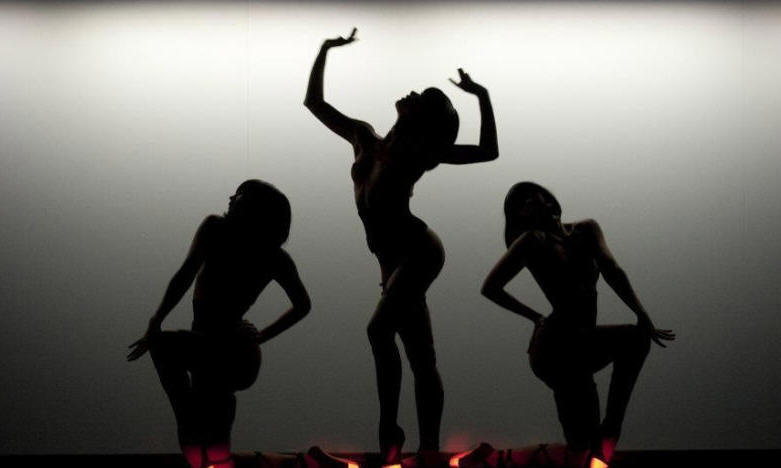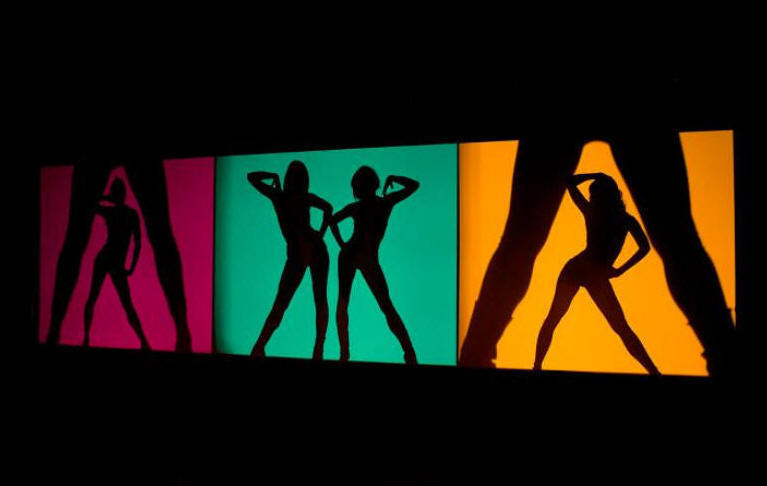MOVIE REVIEWS |
INTERVIEWS |
YOUTUBE |
NEWS
|
EDITORIALS | EVENTS |
AUDIO |
ESSAYS |
ARCHIVES |
CONTACT
|
PHOTOS |
COMING SOON|
EXAMINER.COM FILM ARTICLES
||HOME

Thursday, March 1, 2012
MOVIE REVIEW
Crazy Horse
A World-Famous High Horse Of Art Erotica In Paris

A scene from Frederick Wiseman's documentary "Crazy Horse".
Zipporah Films
by
Omar P.L. Moore/PopcornReel.com
 FOLLOW
FOLLOW
Thursday,
March 1,
2012
Colorful,
vibrant, eye-popping images of erotic art, Frederick Wiseman's documentary
"Crazy Horse" spends ten weeks at the famed Crazy Horse dance establishment in
Paris, home to the world's top nude female dance revue. From the opening
frame Mr. Wiseman promises a spectacle of illusion and artistry, and much of the
time this beautiful, insightful if sometimes unremarkable bit of cinema verite
shows us the internal workings of Crazy Horse and the people behind its glamour
and big show production "Desirs", from the dancing women to the show's director
and choreographer Philippe Decouflé. Refreshingly absent of talking heads,
"Crazy Horse" moves and sashays like its performers, and absorbs and wows like
the vivid decor of the club's herd of plush, ruby-red velvet seats.
"Crazy Horse", which expands to more U.S. cities tomorrow, shows a staple of
France almost as revered as the Eiffel Tower: an iconic 60-year-old club that is
a whole other Parisian world separate from yet deeply connected to the amour of
Paris itself: a cerebral, high-class erotic fantasy world of entertainment and
sensuality that, especially in a solo dance number roughly 40 minutes in, is
often arousing. Much of what we see is sexier than simply observing a
naked woman strut across a stage (we see that too), making the art of suggestive
dance a fluid, playful tease and fascinating exercise for the imagination.
The dances we see inspire many adjectives: magical, racy, discreet, saucy,
elegant and tasteful cabaret, not pornographic or strip-joint material, or even,
with some Dita Von Teese-like exceptions, burlesque as seen in Mathieu Almaric's
film "La Tournee". Mr. Decouflé's choreography nods to Bob Fosse, Michael
Jackson, and France's adopted daughter and national treasure Josephine Baker
among others, and is as beautiful to watch as the accompanying music is to
listen to.
Mr. Wiseman's film goes from its early objective visions to eventually settle as
a subjective and conventional documentary, with interviews of key players.
Some of its conversational pieces dampen the mood and atmosphere of "Crazy
Horse" but there's an inherent understanding that the club hasn't existed for as
long as it has without the people at its heart and its periphery: those who
sweep, clean, light, prepare and spruce up the place, even if some of its
elevated employees gently mock the underlings. The club has its problems
with money, dance numbers that some of the performers don't like, and the
inevitable clashes of interpretation and personality between long-time director
Mr. Decouflé and relatively new and stubborn artistic director Ali Mahdavi, a
bald man with the penetrating eyes of Nosferatu or Mephisto.
The two problems "Crazy Horse" has are, first, its length, which, at nearly two
hours and ten minutes could have been trimmed by at least twenty. Perhaps
Mr. Wiseman wanted to avoid cutting corners and allow the audience to get lost
in the club's environment. He succeeds on both counts almost to the point,
in one or two places, of tedium. The other problem is that the dancers
themselves are mostly seen and not heard. They laugh at blooper-reel like
editions of the dance routines they have borrowed, one of the few moments where
we see them in a different light. The dancers complain, if not protest in
true French style, about a few behind-the-scenes issues. Still, I wanted
to hear more from them. What do they really think? What kinds of
things do they do when not dancing? What is their view of erotica and how
they create it? What is sexy to them?

A scene from Frederick Wiseman's documentary "Crazy Horse".
©Antoine Poupel
The women are clearly passionate and competitive when dancing on stage and
remain friendly, but there's a restraint in them that counters the energy and
brightness of Mr. Wiseman's visually resonant documentary, if not the club
itself. It's hard to imagine that ten weeks went by without any such
investigation of the dancers' thoughts, and sans their philosophies the women
who dance come off as mere objects of facilitation, cogs in a wheel. This
lack of probing of the architects and vessels of erotica marks the one big
disappointment of "Crazy Horse". All too often others are speaking when
the women should, or worse, speak for the women.
In Mr. Wiseman's defense the dancers are extremely hard workers, and he portrays
them as they are, busy during the day and night. Perhaps Mr. Wiseman's
all-access pass to Crazy Horse came with conditions, which may have involved a
"mum" clause to be adhered to by the dancers. Still, the Crazy Horse
club's managing director Andrée Deissenberg (or perhaps another person)
rightfully declares during one conversation with a male journalist that "without
the woman there is no erotica."
Moreover, a telling episode about the dancers' dispositions on erotic expression
come from Mr. Decouflé, who states that the women are uncomfortable touching
each other in one particular dance number. "They don't know how to
pretend," he laments. Mr. Decouflé also doles out many compliments to his
dancers, whom he adores. The dancers are professional through and through.
They execute endlessly, through rehearsal and final act, and are quick studies.
It is worth stating, if not repeating, that the best thing about this
captivating documentary are its dance numbers, many of which are arresting.
Aside from its feast of sexy bodies and rhythms, "Crazy Horse" is strongest when
it examines sensuality and seduction from both sides of the camera. "Desirs"
artistic director Mr. Mahdavi gives a potent analysis of, and distinction
between, beauty in women who are naturally beautiful, and women who have hurdles
to overcome yet find and use a beauty within that makes them more interestingly
beautiful as performers and as people. We understand and witness what Mr.
Mahdavi is speaking of, and later we see his point again when a group of dancers
are chosen ala "Chorus Line" from a small group to participate in the "Desirs"
production.
Mr. Wiseman has been so good for so long at chronicling people as observed
through others and themselves. He's so ably proficient at tactile
representations of human industry and endeavor, and with "Crazy Horse" he gets
the dimensions both visually and rhythmically to come alive. His camera
captures an array of finely-contoured arms, fingers, legs, thighs, breasts,
buttocks, faces, hands, hips and backs, gyrating like gears and machines under
alternating soft and harsh lights and mellow silhouettes against striking color
backdrops.
"Crazy Horse" is a study of the artistry of the human body and the restraint it
has while it works in precise but constant motion. Mr. Wiseman's artistry
remains striking and creates, albeit with the help of the world's most admired
female dance revue club, an engaging if sometimes sprawling view of a Parisian
showbusiness family that labors day and night to get things right for themselves
and the audiences of upper-class if not bourgeois clientele of men and many
women who are entertained nightly.
"Crazy Horse" is not rated by the Motion Picture Association Of America.
It contains nudity, including full frontal female nudity, sensuality and some
language. The film is in the French language with English subtitles. The film's running time is
two hours and eight minutes.
COPYRIGHT 2012. POPCORNREEL.COM. ALL RIGHTS RESERVED.  FOLLOW
FOLLOW
MOVIE REVIEWS |
INTERVIEWS |
YOUTUBE |
NEWS
|
EDITORIALS | EVENTS |
AUDIO |
ESSAYS |
ARCHIVES |
CONTACT
| PHOTOS |
COMING SOON|
EXAMINER.COM FILM ARTICLES
||HOME

 FOLLOW
TWEET
FOLLOW
TWEET
 FOLLOW
FOLLOW